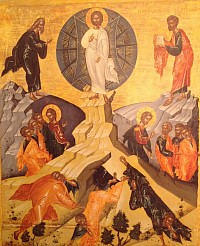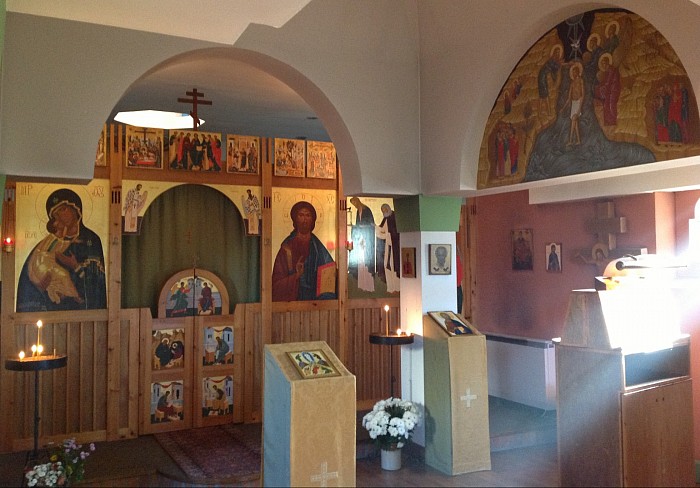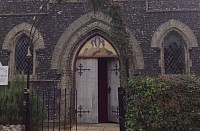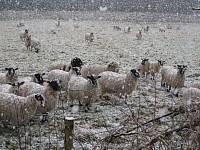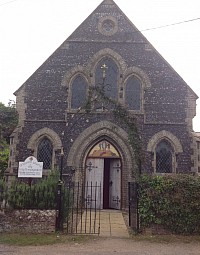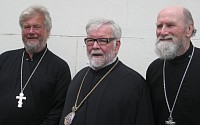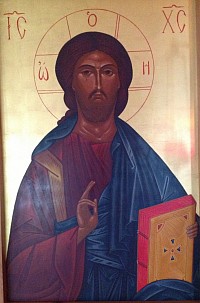Welcome!
Understanding Orthodoxy begins here
WELCOME TO THE CHURCH OF THE HOLY TRANSFIGURATION
We welcome everyone.
If you are an Orthodox Christian visiting this site, much of what you read will be familiar to you. If you are not Orthodox we hope that this site will explain what Orthodoxy is, why we do what we do, and why our church looks as it does.
This site is 'seeded' with a vast array of Orthodox music and our prayers are available for anyone to use to help bring them closer to God. If we have a "mission" it is to bring people closer to God. Anything else is superfluous. Please take your time to browse and know that the people who attend our services pray for you and your needs. When the colour of the text changes that will be a hyperlink carrying you to another window where you will be able to enjoy Orthodox music.
The Church of The Holy Transfiguration, Gt Walsingham, serves a parish community of several nationalities. (The majority of the regular congregation are British, although we also have Cypriots, Poles, Romanians, Ukrainians, and others). We are under the jurisdiction of Nikitas, the Archbishop of Thyateira and Great Britain, based in London at the Greek Cathedral of Divine Wisdom, who is himself under the jurisdiction of Bartholomew, the Ecumenical Patriarch, the Archbishop of Constantinople (Istanbul). We are part of the Orthodox Church - a family of churches which are united in faith and worship, and which have an unbroken continuity with the earliest Christian church.
Our parish is part of the Greek Orthodox Diocese of Thyateira of Great Britain but – for somewhat complicated historical reasons – there is, within that archdiocese, a Deanery of Parishes of Russian tradition, of which we are part. This Deanery is made up of parishes that were at one time under the jurisdiction of Metropolitan Anthony of Sourozh, together with more recently established parishes and communities set up by these older parishes.
All of these parishes and communities work in accordance with the kind of ethos encouraged by Metropolitan Anthony, which was based not only on the development of the Russian liturgical and spiritual tradition that he inspired, but also on the way in which the Moscow Council of 1917-18 had envisaged the future of the Church. This vision – while still seeing the episcopate as the source of authority – involves the development of processes of consultation and collaboration with all the clergy and laity. The Deanery still has structures and activities that reflect this vision.
Part of this vision is a sense that we are a “Missionary Deanery.” This means that we have a vision of a “local church” gradually developing and so are not of “Russian tradition” in any narrow sense of that term. We seek to reach out to the inhabitants of our country from many different ethnic and cultural backgrounds, and while some of the deanery’s parishes sill use a certain amount of Church Slavonic in their services, their tendency is to move towards the use of the local language – English – in worship. (Already, some of the deanery’s parishes, including our own, use only that language.) As a parish and Deanery with this ethos, we hope, among other things, to act as an example to other Orthodox groups in relation to the future of the Orthodox Church in our land.
We are not part of the Moscow Patriarchate, which at present considers itself out of communion with our own Ecumenical Patriarchate. However, our own patriarchate does not consider itself out of communion with the Moscow Patriarchate, members of which are welcome to receive communion at our services. All - whether Orthodox or otherwise - are welcome to attend our services but only members of one of the canonical Orthodox churches are able to receive Holy Communion
The Orthodox tradition is a tradition that most closely follows the worship and beliefs of the Early Church. Jesus was a Jew and Christianity grew from Judaism. As well as explaining what Orthodoxy "is", how Orthodox is lived, and what we believe and practice, within the pages that follow may be seen how close this relationship between Christianity and Judaism continues to this day.
Our services are in English, and we follow the Russian tradition of worship which - except for the music used - differs very little from the forms of the Greek and other Orthodox traditions. Our normal weekly service is the Holy Liturgy on Sunday morning. The Liturgy starts at 10.30 am and lasts about an hour and a half. Everyone - Orthodox or otherwise - is welcome at these services. After the Sunday Liturgy there are refreshments available.
Our parish is part of a Deanery that consists of a number of Orthodox Christian parishes within the Archdiocese of Thyateira and Great Britain. Unlike most of that archdiocese’s parishes, we are not Greek in origin or ethos. The members of our Deanery's parishes are of many different nationalities and include significant numbers of British converts. For historical reasons, we follow a tradition that has its roots in developments of the Russian tradition that occurred outside Russia, and which were inspired by the 1917-18 Moscow council and promoted by Metropolitan Anthony of Sourozh during his time as a church leader in London. In these developments, there is a strong emphasis on decision-making as something that should properly involve consultation with the whole people of God, and on progress towards a “local” Orthodoxy that is not tied to any particular national tradition or language of worship. We seek to proclaim the Orthodox Christian faith to all people in this country through our worship, our outreach, and our witness to this inheritance.
The rota of services for the next few weeks can be found here.
The word 'Liturgy' originates from Greek 'leitourgia' and means 'the work of the people'. Liturgical worship can be traced back to Moses where,in Exodus, God prescribed how worship was to be conducted. The experience of attending an Orthodox Holy Liturgy contains contrasting and paradoxical elements of formality and informality. The formal components being the words and form of the service, and the informal being a relaxed yet deeply personal atmosphere in which nobody minds if people either arrive late or leave early, where children aren't expected to behave like adults, and where people feel free to move around during the service unconstrained by architecture, furniture, or normal secular conventions.
The parish priest is Father Christopher Knight. Cathie Knight leads the choir.
A new wall ikon has been installed in our church, perhaps one of the biggest contemporary wall ikons in the country. Visitors will be greeted by the most wonderful of sights, and we are grateful to our benefactor and the skill of ikon writers we have engaged to make this very special addition. If, in the past, you have visited our church and were impressed, you need to make another visit. Soon! For those unable to visit, the pictures are here;
Following the decision by the Ecumenical Patriarch, Bartholomew, to recognise the legitimacy of the Ukrainian jurisdiction as being distinct from the Moscow Patriarch, the Exarchate have issued the following statement, which can be read here.
If you wish to contact the church, you are invited to do so by email,
or telephone Fr Christopher on 01328 820108. The number to contact in the immediate term in the event Fr Christopher is unavailable is 07708047550.
We aim to ensure that the church is open during the day for visitors and for prayer. Despite our being in a fairly remote part of Norfolk, hardly a week goes by without several people 'dropping by'.
Visitors are ALWAYS welcome, and if you turn up while a service is in progress please don't feel embarrassed about coming in late or needing to leave early. It is perfectly acceptable to us that people should come and go as they please. No one will worry if you arrive late or need to leave before the end. It is more important to us that when you come you find what you need.
Great Walsingham sits in a remote part of Norfolk, a mile outside Little Walsingham (which is famous as a site of pilgrimages which began in the 11th century).
To find the church, Sat Nav users will need to put the post code NR22 6DP into their device. If you are using the new What3Words (W3W) code, our location is "Rivals.Swoop.Pile". Others without a Sat Nav will, from the old town pump in the centre of Little Walsingham, find us by heading off down the hill towards the Anglican Shrine, continue past it over the little hump back bridge, then turn left into Scarborough Rd. Continue along that road till the road opens out with a green in front of you and a left turn. The church will be on your right. You need to be looking out for a Norfolk flint building since the building was originally a Methodist church.
This is a picture of the Church of the Holy Transfiguration.
There are two other Orthodox Churches in the area. In Little Walsingham, within the Anglican Shrine, there is a small pan-Orthodox chapel not currently in use. Elsewhere, by the Coach Park in Little Walsingham, in what was once the Railway Station, there is the church of St Seraphim. This church doesn't have a regular congregation or priest, but services do take place there on special occasions. It is open to visitors on a daily basis, and is being developed as a centre for icon painting, study days, retreats etc.
This picture shows our two priests with our former archbishop. To the left is our parish priest, Fr Christopher. In the middle is Archbishop Gabriel of Comana. On the right is Fr David, who is the Assistant Priest of the parish.
We do not actively seek to convert Western Christians to Orthodoxy, and if you visit us you will experience no pressure to become one of us. You might like to know, however, that many members of our congregation - including our two priests and our subdeacon - are converts, and if you wish to explore Orthodoxy with this in mind we will be delighted to help you in your exploration. We quite understand, however, that while the Orthodox faith welcomes everyone, not everyone feels able to embrace it. There is no shame in deciding, after closer examination, that it is not for you. The purpose of the church is to provide a conduit through which people can express their faith. There is more than one conduit. Oranges are not the only fruit.
Fr Christopher is an academic author whose special interest lies in the bridge between theology and science. Should you be interested in some of his writing I suggest you begin here or here.
Ikons
Visitors may be struck by the many ikons (images) in the church and by the screen across the church (ikonostasis) on which the main ikons are to be found and which divides the altar area from the main body of the church. Ikons feature in all Orthodox churches, and their importance requires some explanation.
They are, for Orthodox Christians, "windows" into the eternal dimension of reality. They are not "realistic depictions" or even "works of art", but are a means by which Christ and his saints are made present to us. We acknowledge this presence by bowing before the ikons and kissing them. The belief that this is proper is rooted in our belief that God was made flesh in Christ, so that all material things are potentially vehicles of God's grace. Veneration of ikons is not idolatry or worship of matter but is - as St.John of Damascus describes it - worship of "the Creator of matter, who for my sake became material and deigned to dwell in matter, who through matter effected my salvation."
Like everyone who may be seen in a photograph, those represented had or have lives, hearts, experiences, relations, friends, good days and bad days. That they lived, breathed and deserve not to be forgotten is no different whether they are viewed in a photograph or a painting or an ikon. The saints are no different. They had lives like our own, but they also had lives that serve as models which some of us may learn from. In Orthodoxy we choose to remember them in Ikons, and those who we remember in Walsingham are described here.
.
OUR CALENDAR
This parish uses the Gregorian or “new” calendar: the one that corresponds to the calendar used by secular society. We therefore celebrate Christmas (25th December) on the same day as Western Christians do. However, some Orthodox – such as those in Russia - still follow the Julian or “old” calendar that was known to and used by the Fathers of the church. This calendar was the best available in their time, but because of its way of calculating leap years, it gets the length of the year slightly wrong. Although the error amounts to only about three days in every four hundred years, this error means that the old calendar is at present thirteen days behind the new calendar. For this reason, those who use the old calendar celebrate Christmas on what that calendar regards as 25th December but we regard as 7th January, thirteen days after our own Christmas.
A further complication is Easter (usually called Pascha by us). Because of the variety of dates used in different parts of the early Christian world, the Fathers of the church decided in the fourth century that uniformity was desirable. They decreed that it was proper for Easter – the feast of Christ’s resurrection - to be on a Sunday, the day of resurrection. They also decided that, because the resurrection was linked historically to the Jewish Passover, Easter should follow immediately after that feast, which was linked to the first full moon after the Spring equinox. Their ruling was therefore that Easter should not be celebrated on some fixed date but should be on the first Sunday after the first full moon after the Spring equinox - unless that particular Sunday coincided with Passover, in which case it should be on the following Sunday.
Western Christians still follow this rule (though the last of these provisions seems to have been forgotten). However, Orthodoxy now follows the Fathers’ erroneous astronomical calculations rather than their intentions. While some regard this as regrettable, they recognize the force of the argument that Easter, being the main celebration of the Christian year, is a feast that should be celebrated at the same time throughout the Orthodox world. For this reason, even those Orthodox who normally use the new calendar continue to calculate the date of Easter using the old calendar’s notion of when the Spring equinox occurs – nowadays thirteen days after the true Spring equinox - together with other ancient and inaccurate predictions of the occurrence of the full moon. The result is that while the Orthodox celebration of Easter is sometimes on the same day as that used by Western Christians, it can be up to five weeks later.
Regarding how it is that Passover doesn't always align with Easter, there is an interesting account here.
